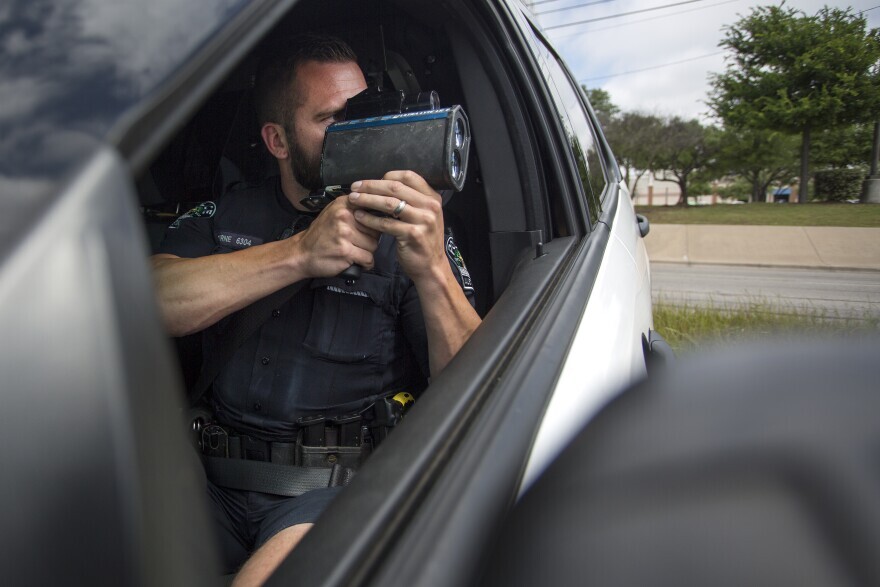TxDOT wants cops to crack down on speeders, but APD’s traffic enforcement units are understaffed
Friday, June 3, 2022 by
Nathan Bernier, KUT With traffic crashes killing about 10 people a day across the state, the Texas Department of Transportation is launching its first-ever safety campaign focused on the leading cause of road deaths: speeding.
The new campaign includes an increase in speed limit enforcement by police across Texas from June 7-21, officials said at the unveiling Thursday outside TxDOT’s Austin District headquarters.
“It often takes the threat of an expensive ticket or other legal consequences to get drivers’ attention and to motivate them to make adjustments to their driving,” Michael Chacon, TxDOT’s director of traffic safety, said.
Eric Miesse, an Austin police commander who oversees highway enforcement, said the Austin Police Department supports the campaign, which is called Operation Slowdown.
“Drivers go faster than the speed limit all the time and yet many haven’t been involved in a wreck,” Miesse said. “But what’s important to keep in mind is that your luck may run out.”
But APD is so short-staffed that it has shifted efforts away from cracking down on speeders and other traffic violators in recent years. APD’s traffic enforcement units have been stripped of officers, who’ve been reassigned to patrol duties like responding to 911 calls.
The city of Austin earlier this year even floated the idea of hiring Travis County constables and sheriff’s deputies to work overtime traffic enforcement shifts. But with Travis County facing its own law enforcement staffing shortages, the proposal hasn’t happened yet.
“Unfortunately, most of my staff from highway enforcement had to go back to patrol to help with our staffing needs,” Miesse told KUT after the TxDOT news conference. “We had a lot of retirements and a lot of people who left the department early.”
About 10.5 percent of APD’s 1,809 sworn positions are vacant, according to a memo last month from the city’s assistant city manager.
That’s a lower vacancy rate than earlier in the year when 12 percent of sworn positions were vacant. A cadet class graduated in January, adding 66 officers to the force. Another class is due to graduate in November.
“Long story short, there’s no specific program set up for us to help participate in (Operation Slowdown) due to staffing,” said William White, a lieutenant with APD’s Highway Enforcement Command. “We participate in the sense of, if an officer sees a driver committing a violation, he has that option to pull the subject over.”
APD’s state-funded program to pay officers extra for working overtime traffic enforcement shifts – the Selective Traffic Enforcement Program – has fewer participants because of the overwhelming demand to work overtime patrol duties, White said.
Over the past five years, speeding citations issued by Austin police plunged from an average of about 100 tickets a day in 2017 to 10 a day in 2021, a decline of 90 percent. Over the same period, Austin’s traffic deaths reached record highs.
And 2022 is on track to be even worse.
So far this year, 43 people have died in traffic crashes, according to a city dashboard. That’s one more death than at the same point in 2021. The data was last updated May 19.
The city has seen an even more dramatic rise in the number of people seriously injured in crashes: 219 so far this year, up 20 percent from the same time in 2021.
Even after adjusting for Austin’s rapid population growth, the number of people killed in traffic is rising: There were 11.4 deaths per 100,000 residents in 2021, 9.2 in 2020, 9 in 2019 and 7.5 in 2018.
The rate of serious injuries per 100,000 residents has gone up and down in recent years: There were 51.2 serious injuries per 100,000 residents in 2021, 42.1 in 2020, 56.5 in 2019 and 56.3 in 2018.
Lewis Leff, the city’s transportation safety officer, told KUT that traffic enforcement is crucial to reducing road deaths. But he said designing streets and highways to be safer is more effective.
“Engineering is the lead strategy to mitigate speeds on the roadways over the long term,” an approach Leff said takes “a lot of time and money and effort … based on what we’ve been building out over the past 80 years.”
This story was produced as part of the Austin Monitor’s reporting partnership with KUT.
The Austin Monitor’s work is made possible by donations from the community. Though our reporting covers donors from time to time, we are careful to keep business and editorial efforts separate while maintaining transparency. A complete list of donors is available here, and our code of ethics is explained here.
You're a community leader
And we’re honored you look to us for serious, in-depth news. You know a strong community needs local and dedicated watchdog reporting. We’re here for you and that won’t change. Now will you take the powerful next step and support our nonprofit news organization?






